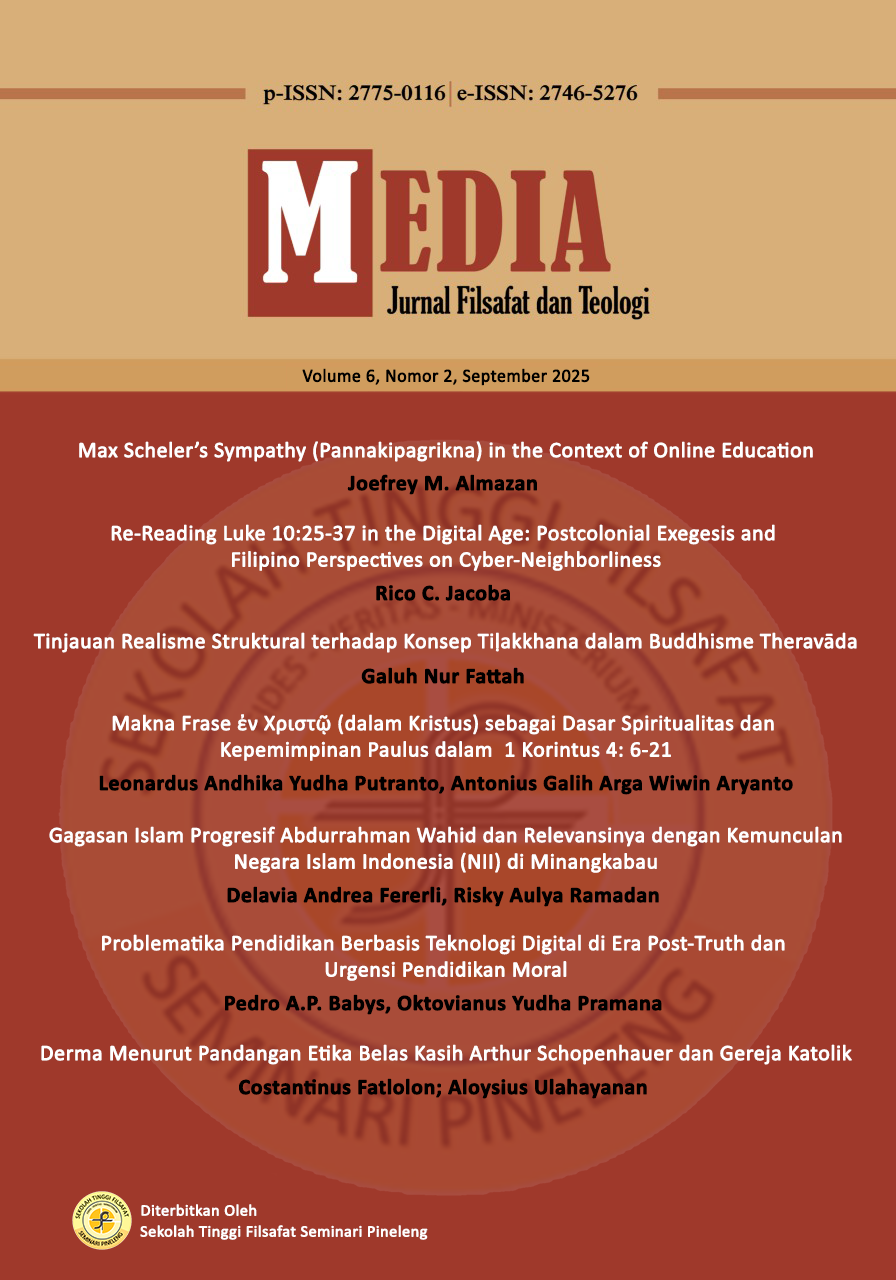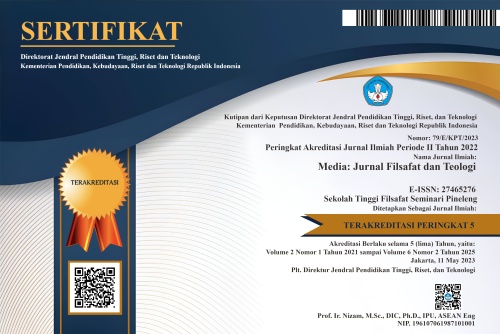Tinjauan Realisme Struktural terhadap Konsep Tiḷakkhana dalam Buddhisme Theravāda
DOI:
https://doi.org/10.53396/media.v6i2.593Keywords:
Structural Realism; Tiḷakkhana; Theravāda Buddhism; Aniccā; Dukhhā; AnattāAbstract
This research article examines the concept of Tiḷakkhana in Theravāda Buddhism, which the researcher then referred to as Buddhist realism using structural realism as the formal object of research as well as a comparative object. The method used in writing this research article is the literature study method with the following stages: identification of research problems; literature seeking; literature evaluation; information synthesis; preparation of a theoretical or analytical framework; and writing the results of the literature study. This study found that structural realism has harmony with Buddhist realism (Ti ḷakkhana) which consists of three characteristics, namely change/impermanence (Aniccā), suffering (Dukkhā), and selflessness/absence of essence (Anattā). Although there is harmony between the two type of realism, especially in the metaphysical and epistemological aspects, there is a very contrasting difference in the ethical aspect, namely that structural realism only focuses on the metaphysical and epistemological aspects of structure as something that exists and is worthy of trust, so that the ethical aspect is completely ignored. While Buddhist realism accommodates ethical aspects that significantly influence the structure of reality, both metaphysically and epistemically. Another thing that was found is the fact that ontologically.
References
Arenthart, Jonas R. Becker, and Otávio Bueno. “Structural Realism and the Nature of Structure.” European Journal for Philosophy of Science 5 (2015): 111–39. https://doi.org/10.1007/s13194-014-0100-y.
Aristotle. Aristotle’s Metaphysics. Edited by Hugh Lawson-Tancred. English. London: Pinguin Classics, 1998.
Audi, Robert. Epistemology: A Contemporary Introduction to the Theory of Knowledge. New York: Routledge, 2010.
Bodhi, Bhikkhu. “Anatta Sutta (AN 6.100).” DhammaCitta, 2020. https://dhammacitta.org/teks/an/an6/an6.100-id-bodhi.html.
———. “Dukkha Sutta (AN 6.75).” DhammaCitta. Accessed January 9, 2025. https://dhammacitta.org/teks/an/an6/an6.75-id-bodhi.html.
———. In the Buddha’s Words: An Anthology of Discourses from the Pāli Canon. Boston: Wisdom Publications, 2005.
Buroker, Jill Vance. Kant’s Critique of Pure Reason: An Introduction. Cambridge: Cambridge University Press, 2006.
Creswell, John W. Research Design: Qualitative, Quantitative, and Mixed Methods Approaches. California: Sage Publications, 2014.
Epicurus. The Epicurus Reader: Selected Writings and Testimonia. Edited by Brad Inwood and L.P. Gerson. English. Indianapolis: Hackett Publishing Company, 1994.
Fattah, Galuh Nur. “Anattā Sebagai Konsep Manusia Non-Esensial Dalam Buddhisme Theravāda: Sebuah Landasan Kritik Terhadap Cogito Ergo Sum Renĕ Descartes.” Universitas Gadjah Mada, 2023.
Feynman, Richard. “The Feynman Lectures on Physics Vol I.” Addison Wesley, 1970. https://www.feynmanlectures.caltech.edu/I_04.html.
Fraassen, Bas C. van. The Scientific Image. Oxford: Clarendon Press, 1980.
French, Steven. The Structure of the World: Metaphysics and Representation. Oxford: Oxford University Press, 2014.
Heraclitus. Heraclitus: Fragments. Edited by T.M. Robinson. English. Toronto: University of Toronto Press, 1987.
Kalupahana, David J. A History of Buddhist Philosophy: Continuities and Discontinuities. Delhi: University of Hawaii Press, 2006.
Kant, Immanuel. Groundwork of the Metaphysic of Morals. Edited by H.J Paton. English. New York: Harper Torchbook, 1964.
Keown, Damien. A Dictionary of Buddhism. Oxford: Oxford University Press, 2003.
Kheminda, Ashin. Abhidhammatthasaṅgaha: Manual Abhidhamma (Ajaran Tentang Realitas Tertinggi) Bab 1: Kesadaran. Edited by Laksana Feronica and Magdalena Wartono. 3rd ed. Jakarta Barat: Dhammavihārī Buddhist Studies, 2021.
———. Kamma: Pusaran Kelahiran & Kematian Tanpa Awal. Edited by Feronica Laksana and Magdalena Wartono. 2nd ed. Jakarta Barat: Dhammavihārī Buddhist Studies, 2020.
Ladyman, James, Don Ross, David Spurrett, and John Collier. Every Thing Must Go: Metaphysics Naturalized. Oxford: Oxford University Press, 2007.
Loux, Michael J. Metaphysics: A Contemporary Introduction. New York: Routledge, 2002.
Mahāthera, Narada. Buddhism in a Nutshell. Kandy: Buddhist Publication Society, 1982. www.buddhanet.net.
Maxwell, Grover. “The Ontological Status of Theoretical Entities.” In Philosophy of Science: An Historical Anthology, edited by Timothy McGrew, Marc Alspector-Kelly, and Fritz Allhoff, 451–58. Oxford: Wiley-Blackwell, 2009.
Moreland, J. P, and William Lane Craig. Philosophical Foundations for a Christian Worldview. Illinois: InterVarsity Press, 2003.
Ñāṇamoli, Bhikkhu, and Bhikkhu Bodhi. “Majjhima Nikāya 1: Mūlapariyāya Sutta.” DhammaCitta. Accessed July 6, 2024. https://dhammacitta.org/teks/mn/mn001-id-bodhi.html.
Plato. The Republic of Plato. Edited by Allan Bloom. English. New York: Basic Books, 1991.
Sujato, Bhikkhu. “Anicca Sutta (SN 22.45).” Sutta Central. Accessed January 8, 2025. https://suttacentral.net/sn22.45/en/sujato?lang=en&layout=plain&reference=none¬es=asterisk&highlight=true&script=latin.
Supelli, Karlina. “Bingkai Kurus Realisme Struktural Epistemik.” Jurnal Filsafat Dan Teologi STF 12, no. 2 (2013): 153–90. https://doi.org/10.36383/diskursus.v12i2.102.
Synder, David N. The Complete Book of Buddha’s Lists - Explained. Nevada: Vipassana Foundation, 2009.
Taylor, C.C.W. The Atomists, Leucippus and Democritus: Fragments. Toronto: University of Toronto Press, 1999.
Thanissaro, Bhikkhu. “Anattalakkhaṅa Sutta: Saṃyutta Nikāya (SN 22.59).” DhammaCitta, 2009. https://dhammacitta.org/teks/sn/sn22/sn22.059-id-than.html.
Thera, Nyanaponika. The Three Basic Facts of Existence: I. Impermanence (Anicca). Kandy: Buddhist Publication Society, 2008.
Thera, Piyadassi. “Ratana Sutta (SN 2.1).” Access to Insight, 1999. https://www.accesstoinsight.org/tipitaka/kn/snp/snp.2.01.piya.html.
Votsis, Ioannis. “Structural Realism: Continuity and Its Limits.” Boston Studies in the Philosophy and History 281 (2010): 105–17. https://doi.org/10.1007/978-90-481-9597-8_6.
Worrall, John. “Structural Realism: The Best of Both Worlds?” Dialectica 43, no. 1–2 (1989): 99–124. https://doi.org/10.1111/j.1746-8361.1989.tb00933.x.
Downloads
Published
How to Cite
Issue
Section
License
Copyright (c) 2025 Galuh Nur Fattah

This work is licensed under a Creative Commons Attribution 4.0 International License.













